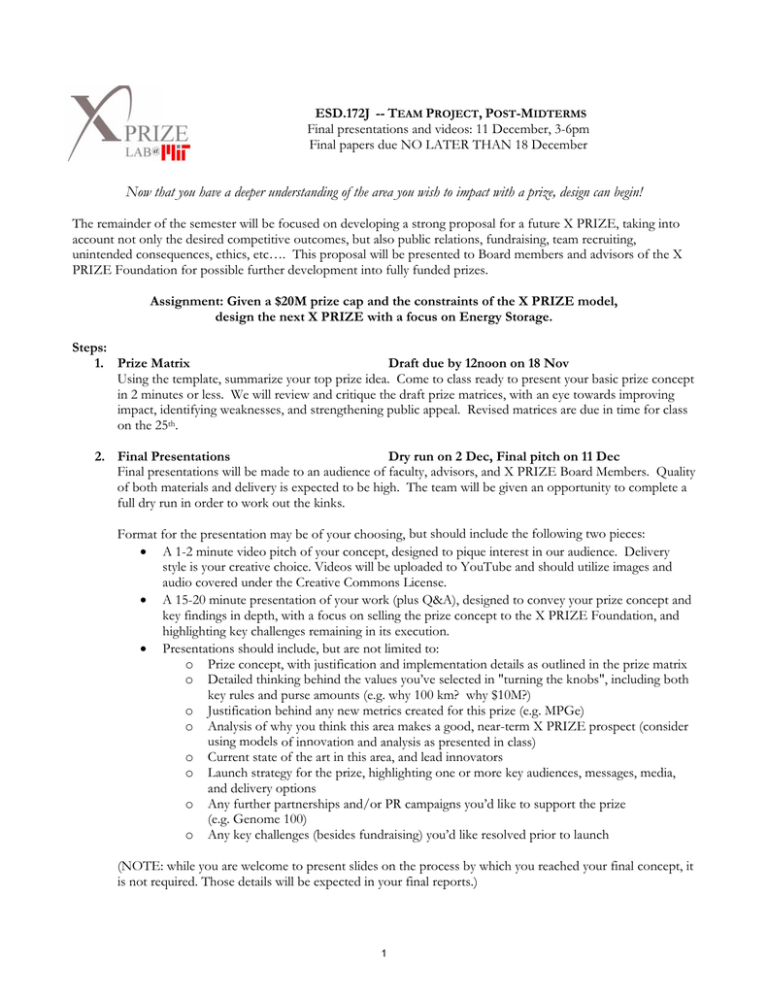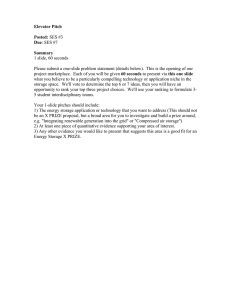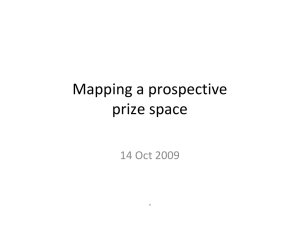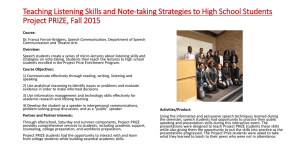- ESD.172 --
advertisement

ESD.172- -- TEAM PROJECT, POST-MIDTERMS Final presentations and videos: 11 December, 3-6pm Final papers due NO LATER THAN 18 December Now that you have a deeper understanding of the area you wish to impact with a prize, design can begin! The remainder of the semester will be focused on developing a strong proposal for a future X PRIZE, taking into account not only the desired competitive outcomes, but also public relations, fundraising, team recruiting, unintended consequences, ethics, etc…. This proposal will be presented to Board members and advisors of the X PRIZE Foundation for possible further development into fully funded prizes. Assignment: Given a $20M prize cap and the constraints of the X PRIZE model, design the next X PRIZE with a focus on Energy Storage. Steps: Draft due by 12noon on 18 Nov 1. Prize Matrix Using the template, summarize your top prize idea. Come to class ready to present your basic prize concept in 2 minutes or less. We will review and critique the draft prize matrices, with an eye towards improving impact, identifying weaknesses, and strengthening public appeal. Revised matrices are due in time for class on the 25th. 2. Final Presentations Dry run on 2 Dec, Final pitch on 11 Dec Final presentations will be made to an audience of faculty, advisors, and X PRIZE Board Members. Quality of both materials and delivery is expected to be high. The team will be given an opportunity to complete a full dry run in order to work out the kinks. Format for the presentation may be of your choosing, but should include the following two pieces: • A 1-2 minute video pitch of your concept, designed to pique interest in our audience. Delivery style is your creative choice. Videos will be uploaded to YouTube and should utilize images and audio covered under the Creative Commons License. • A 15-20 minute presentation of your work (plus Q&A), designed to convey your prize concept and key findings in depth, with a focus on selling the prize concept to the X PRIZE Foundation, and highlighting key challenges remaining in its execution. • Presentations should include, but are not limited to: o Prize concept, with justification and implementation details as outlined in the prize matrix o Detailed thinking behind the values you’ve selected in "turning the knobs", including both key rules and purse amounts (e.g. why 100 km? why $10M?) o Justification behind any new metrics created for this prize (e.g. MPGe) o Analysis of why you think this area makes a good, near-term X PRIZE prospect (consider using models of innovation and analysis as presented in class) o Current state of the art in this area, and lead innovators o Launch strategy for the prize, highlighting one or more key audiences, messages, media, and delivery options o Any further partnerships and/or PR campaigns you’d like to support the prize (e.g. Genome 100) o Any key challenges (besides fundraising) you’d like resolved prior to launch (NOTE: while you are welcome to present slides on the process by which you reached your final concept, it is not required. Those details will be expected in your final reports.) 1 3. Final Reports (Team & Individual) Due NO LATER THAN 18 Dec (no extensions) Final team reports are intended to capture details of process, analysis, and research that may not be as relevant or interesting for the presentation audiences. In addition to the materials presented on 11 Dec, the team should turn in one final report, 10-15 pages in length, plus appendices. These reports should include: • Final prize matrix and justification, including any reviews you may have conducted on market size, existing solutions in the space, challenges to implementation, etc. • Process flow detailing your journey from initial concept to final presented conclusions • Analysis for your final prize concept By the same deadline, each individual should also submit a 1-2 page summary on where you believe prizes fit in the innovation ecosystem. Specifically, highlight 3 situations or market conditions in which you think incentive prizes work well, and 3 where you think they fare less well. As in the first assignment of the semester, these should not be prize ideas (e.g. high efficiency cars), but rather characteristics of a space needing innovation (e.g. there is more than one potential competitor). Justify your judgment. 2 MIT OpenCourseWare http://ocw.mit.edu ESD.172J / EC.421J X PRIZE Workshop: Grand Challenges in Energy Fall 2009 For information about citing these materials or our Terms of Use, visit: http://ocw.mit.edu/terms.




